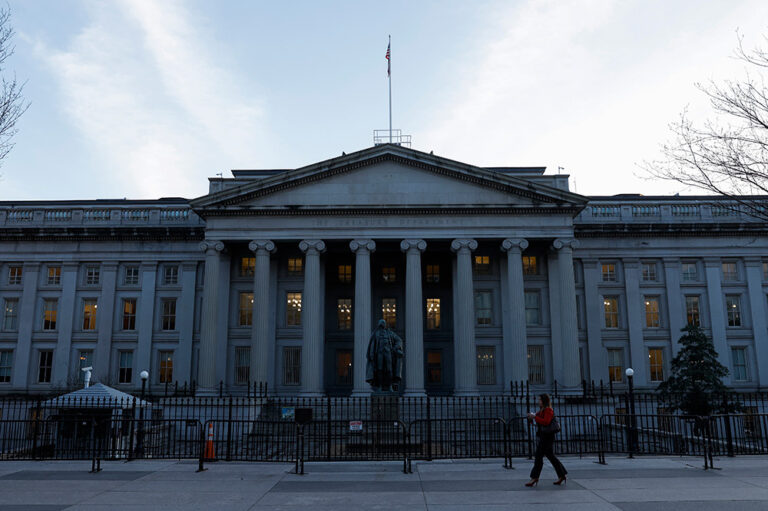The U.S. Treasury reported that total federal borrowing from the public reached $30.2 trillion in FY2025 — the highest amount ever recorded. That figure represents the net amount that the United States Treasury has borrowed from creditors by issuing securities that raise cash to support government activities. Debt held by the public does not include intragovernmental debt, which, in simple terms, is debt that the government owes itself. As the United States continues to borrow a significant amount of money each year, let’s take a closer look at a few key characteristics of Treasury borrowing that can affect its budgetary cost, including the different types of Treasury securities issued to the public as well as trends in interest rates and maturity terms.
Types of Treasury Securities
The U.S. Treasury offers marketable and nonmarketable securities. Marketable securities are sold at auction in various maturities and traded on secondary markets. Such securities represented 98 percent of all debt held by the public as of October 2025. Nonmarketable securities are issued directly to buyers (rather than auctioned) and are not traded in secondary markets; that type of issuance made up just 2 percent of total debt held by the public at the end of October 2025.
Marketable Treasury securities are issued in various forms:
- Treasury Bills have a maturity of one year or less. Such short-term securities are issued at a discount and the face value is paid upon maturity. Bills represented about 22 percent of all outstanding marketable Treasury debt at the end of October 2025.
- Treasury Notes have maturities ranging from two to 10 years. Notes are coupon securities, which means that the semiannual interest payments are set at the time of issuance and purchasers collect the principal at maturity. Notes are the single largest category of Treasury securities, representing about 52 percent of all marketable debt at the close of Octboer 2025.
- Treasury Bonds have maturities of more than 10 years. Bonds are also coupon securities and represented about 17 percent of all marketable debt at the end of October 2025.
- Treasury Inflation-Protected Securities, or TIPS, have maturities of 5, 10, and 30 years. The principal amount on TIPS are adjusted semiannually to account for inflation; interest is paid every six months on the adjusted principal. TIPS represented roughly 7 percent of all marketable debt at the end of October 2025.
- Floating-Rate Notes (FRNs) have a maturity of two years and a rate of interest that is adjusted each quarter; the rate is based on the prevailing interest rate for 13-week Treasury bills. Introduced in 2014, FRNs represented 2 percent of total marketable debt at the end of October 2025.
While Treasury notes account for the majority of outstanding securities, the share of marketable debt represented by such securities has declined over the years — from 66 percent in October 2015 to 52 percent today. That share has declined due to the increased issuance of other securities such as bonds and bills in response to the federal government’s borrowing needs. For example, bills represented 13 percent of total marketable debt at the end of October 2015, but borrowing to address the pandemic boosted that share to 24 percent in 2020, reflecting the comparative ease with which the Treasury can raise cash quickly by issuing bills. Today, bills represent 22 percent of marketable debt as pandemic-related borrowing needs have abated.
Average Interest Rate on Treasury Securities
Treasury data show that the average interest rate on all U.S. interest-bearing debt declined from 4.7 percent in October of 2005 to 3.4 percent as of October 2025. However, the average interest rate varied during that time period, especially during economic downturns. The average interest rate began to fall at the onset of the 2008 financial crisis and remained low throughout the recovery, reaching 2.2 percent in November 2016. At the end of 2019, before the pandemic hit, the average interest rate had only crept up to 2.4 percent. The rate briefly declined during the COVID-19 pandemic to a 20-year-low of 1.6 percent near the end of 2021 but has since been on an upward climb and reached 3.3 percent starting in July 2024 and 3.4 percent since July 2025.
The daily interest rates for both 3-month Treasury bills and 10-year Treasury notes experienced notable fluctuations over the last 20 years. At the beginning of June 2005, the daily yield on Treasury bills was 3.0 percent and the yield on notes was 3.9 percent, still reflecting the heightened demand for safe investments in light of the 2001 recession. As the economy recovered and investor confidence in the economy grew between 2003 and 2007, the demand for Treasury securities lessened and thus the yields on bills and notes both rose to around 5 percent. Then, by the late fall of 2008 when the Great Recession was at its worst, bill yields plummeted to a low of 0.01 percent, and remained below 1 percent until the middle of 2017. Meanwhile, the yield on notes fell to around 2.0 percent in late 2008 and averaged 2.5 percent over the next 10 years. Following a 5-year peak of 2.5 percent in early 2019, the yield on Treasury bills at the end of 2020 had fallen to just 0.09 percent as the economic fallout associated with the COVID-19 pandemic persisted. Note yields, on the other hand, had reached a 5-year peak of 3.2 percent in late 2018 before dropping to just 0.9 percent at the end of 2020. Those rates increased in the following years as the Federal Reserve undertook monetary policy actions to battle high levels of inflation; rates peaked in October 2023 for note yields at 5.0 percent and 5.6 percent for bills. As of the beginning of December 2025, note yields were 4.1 percent and bills were 3.8 percent, partly influenced by recent cuts to the target for the federal funds rate.
Average Maturity of Treasury Securities
The average weighted maturity of all marketable debt dropped to just four years at the height of the Great Recession in December 2008 as the Treasury issued significantly more short-term securities to raise cash quickly to combat the economic fallout. With interest rates at low levels over the last few years, the Treasury took advantage of the opportunity to lengthen the average maturity of its debt and lock in low rates for a longer period. However, the average maturity dropped from 70 months in February 2020 to 62 months in June 2020 as the Treasury ramped up short-term borrowing quickly to address the effects of the COVID-19 pandemic. In May 2023, average maturity rose to the highest duration over the last 20 years, reaching 75 months, as some of the short-term borrowing was replaced by longer-term maturities. The current average maturity has declined since then to 71 months, which is 6 months longer than the 20-year historical average.
Image credit: Photo by Hisham Ibrahim / Getty Images
Further Reading
The Fed Reduced the Short-Term Rate Again, but Interest Costs Remain High
High interest rates on U.S. Treasury securities increase the federal government’s borrowing costs.
Quarterly Treasury Refunding Statement: Borrowing Up Year Over Year
Key highlights from the most recent Quarterly Refunding include an increase in anticipated borrowing of $158 billion compared to the same period in the previous year.
Experts Identify Lessons from History for America Today
A distinguished group of experts to evaluate America’s current fiscal landscape with an historical perspective.


